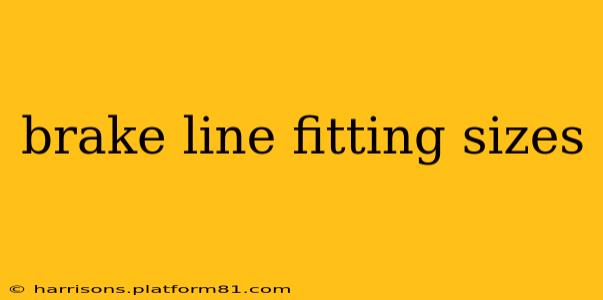Understanding brake line fitting sizes is crucial for safe and effective brake system maintenance and repair. Incorrect fittings can lead to leaks, brake failure, and potentially dangerous situations. This guide will delve into the common sizes, types, and considerations for brake line fittings. We'll also address some frequently asked questions surrounding this topic.
What are the standard brake line fitting sizes?
Brake line fittings come in a variety of sizes, primarily defined by their diameter and thread pitch. The most common sizes are expressed in inches (e.g., 3/16", 1/4", 5/16", etc.), referring to the inside diameter of the tubing. However, the thread size is equally critical, as it determines which fitting will correctly mate with the brake line and components. These thread sizes often follow standards like SAE (Society of Automotive Engineers) or metric specifications. You'll need to consult your vehicle's repair manual or a parts catalog to determine the precise fitting size for your specific make and model. Failing to match these precisely can lead to leaks or the inability to connect properly.
What types of brake line fittings are there?
Several types of brake line fittings exist, each designed for specific applications and connections:
-
Inverted Flare Fittings: These are perhaps the most common type, featuring a flared end that is inverted into the fitting. This creates a reliable seal.
-
Double Flare Fittings: Offering enhanced sealing compared to single flare fittings, double flare fittings provide a stronger, more leak-resistant connection.
-
SAE Flare Fittings: These are standardized fittings used across a wide range of vehicles and applications.
-
Metric Flare Fittings: Used in vehicles manufactured outside North America or in newer models with metric-based components.
-
Compression Fittings: These fittings use a compression mechanism to create a seal, often found in higher-pressure brake systems or specialized applications.
How do I identify brake line fitting sizes?
Identifying the size requires careful observation and potentially the use of measuring tools.
-
Visual Inspection: Begin by carefully inspecting the existing fitting. Look for markings indicating the size, often engraved on the fitting itself.
-
Measuring the Diameter: If no markings are present, use a caliper to measure the inside diameter (ID) of the brake line tubing. This measurement will correspond to the nominal fitting size.
-
Thread Pitch Measurement: Use a thread pitch gauge to determine the thread pitch of the fitting. This is crucial for ensuring a proper connection.
-
Checking Repair Manual: Consult your vehicle's service manual for a definitive list of brake line fitting sizes.
What tools do I need to work with brake line fittings?
Working with brake lines and fittings requires specific tools to avoid damage or injury. Essential tools include:
- Tubing Cutter: Provides clean, accurate cuts for consistent fitting installation.
- Flare Tool: Critically important for creating precisely sized flares on the brake line tubing.
- Wrench Set: The correct wrench size is necessary for tightening fittings without damaging them.
- Brake Line Flaring Tool: This creates the required flare for proper seating.
Can I use different sizes of brake line fittings?
No. Using different sizes of brake line fittings is highly discouraged. Incompatibility can result in leaks, compromised braking performance, and potentially dangerous driving conditions. Always replace fittings with the exact same size and type as the originals.
Where can I find brake line fitting sizes for my car?
The most reliable sources for identifying brake line fitting sizes for your vehicle are:
- Your vehicle's repair manual: This manual provides detailed specifications for all parts of your car, including braking systems.
- A reputable auto parts store: Staff members can typically identify the correct parts based on your vehicle's year, make, and model.
- Online parts catalogs: Many online parts stores have detailed databases that allow you to search for brake lines and fittings based on your vehicle's information.
By understanding brake line fitting sizes and properly selecting the correct replacements, you ensure the safety and reliability of your vehicle's braking system. Always prioritize safety and consult a qualified mechanic if you're unsure about any aspect of brake system maintenance or repair. Remember, this information is for guidance only. Always refer to your vehicle’s specific repair manual for accurate details.
